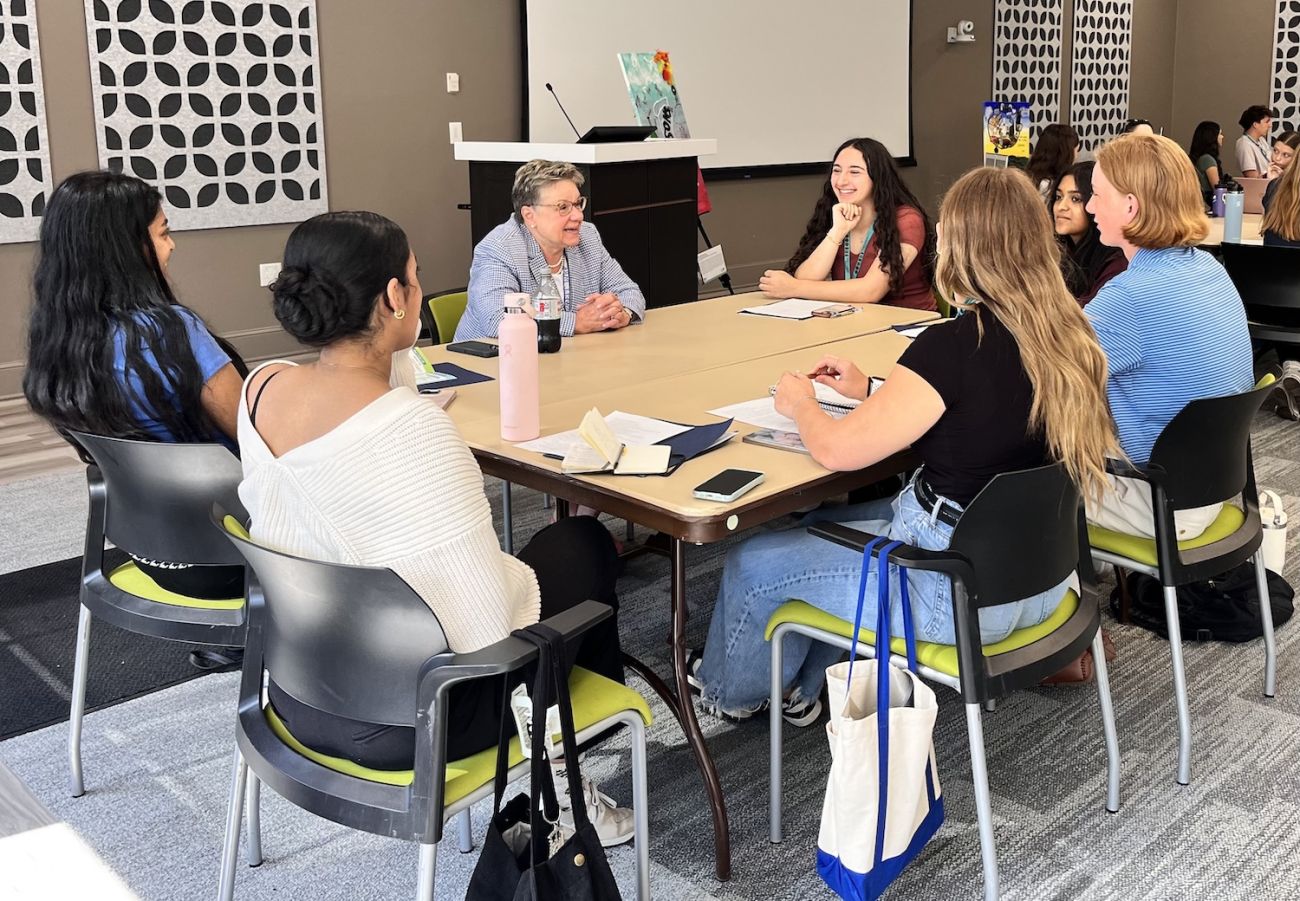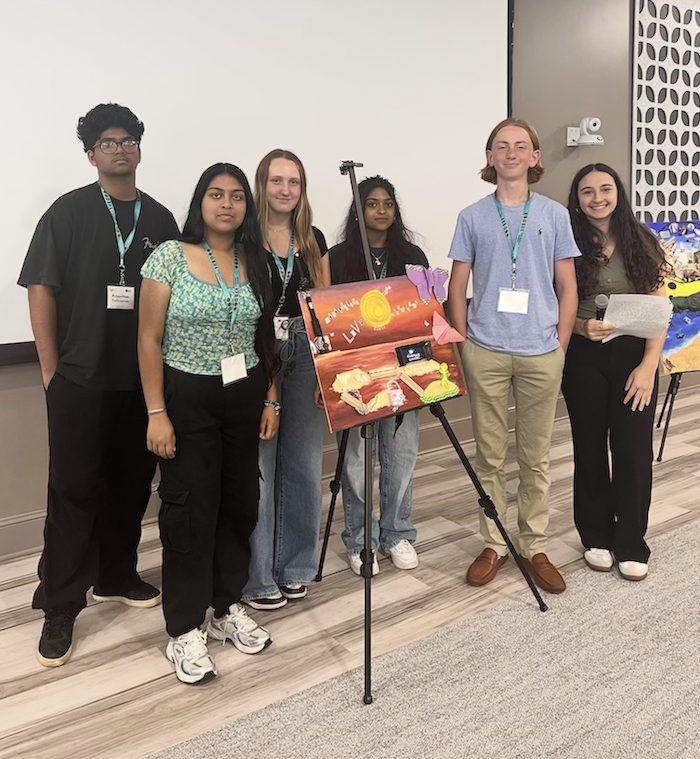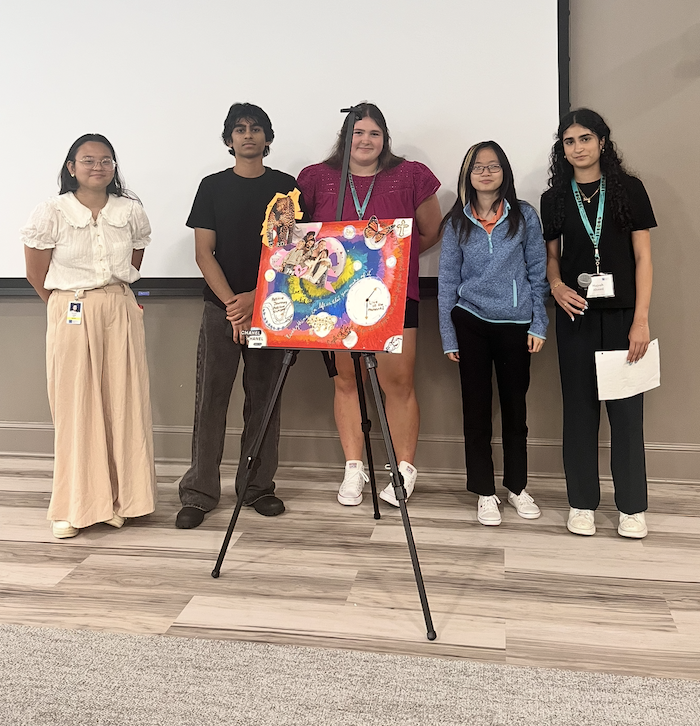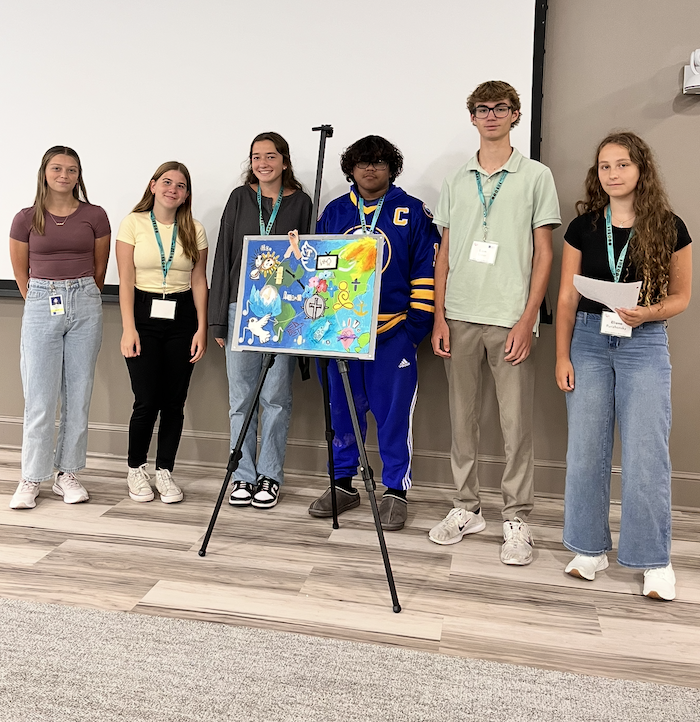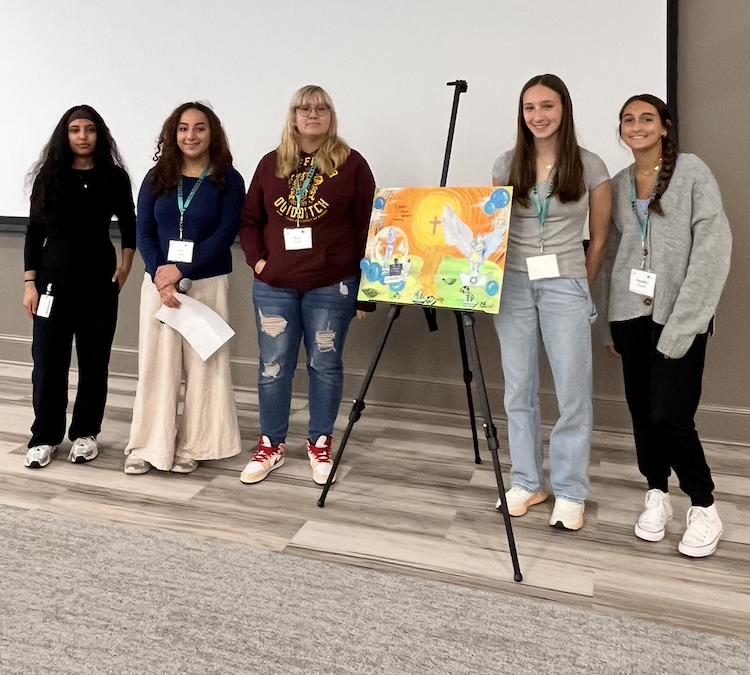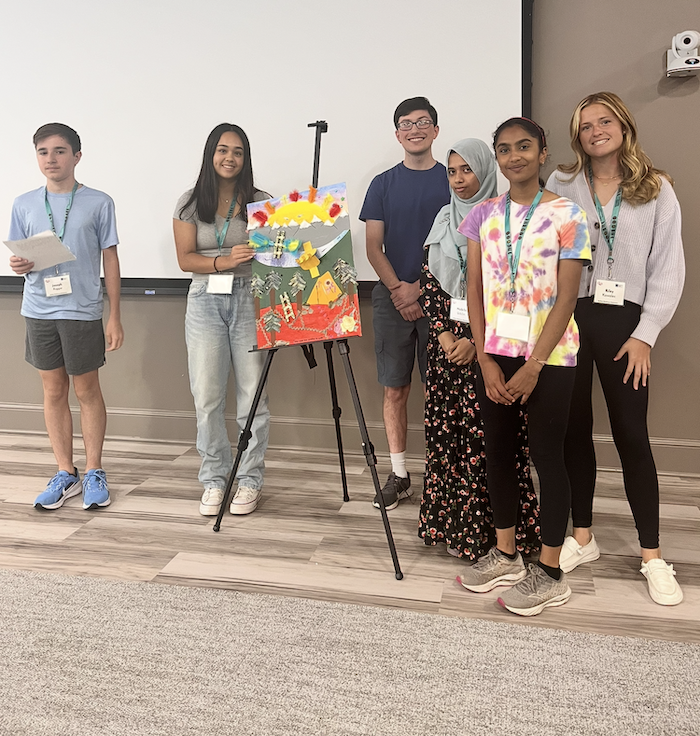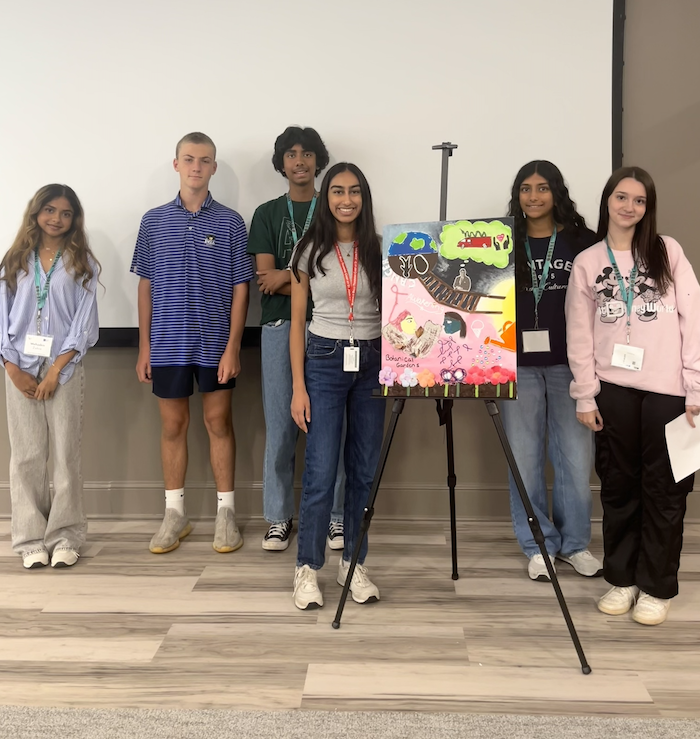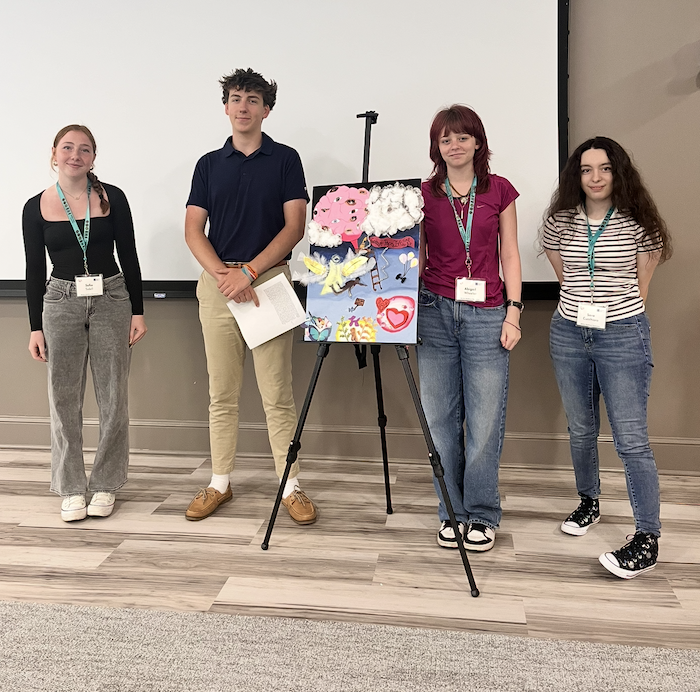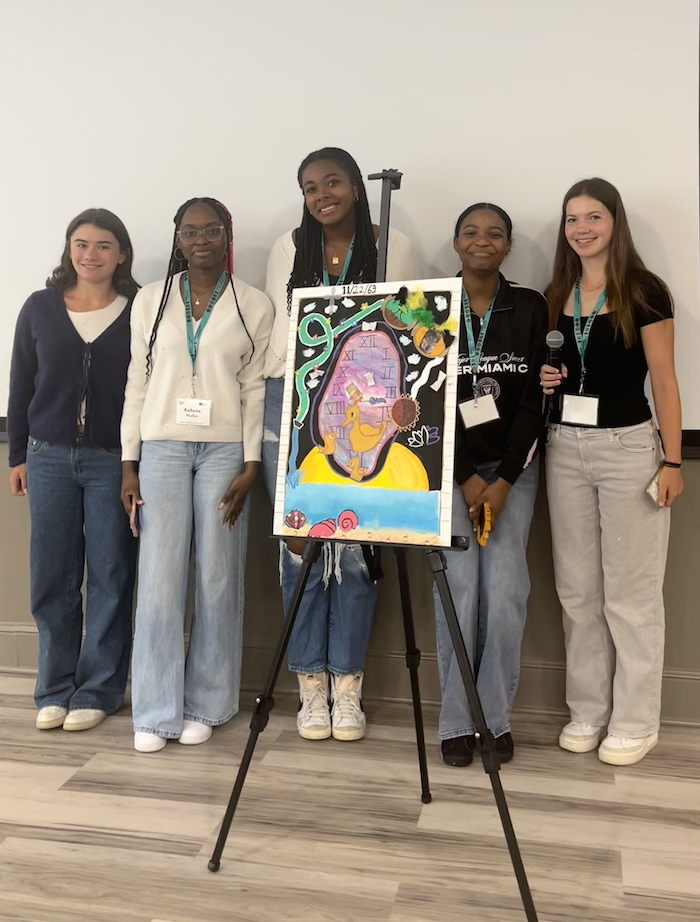The Storyboard Project is the center hub of the BHE program.
Students interviewed Roswell Park cancer survivors, patients and associates who have gone through the cancer journey. Afterward, students built storyboards of what they heard, interpreted, and learned, assisting them in gaining confidence by conducting difficult interviews and learning to lend compassion, curiosity, and respect. Students were prepared to ask the right questions during their interviews to understand what the cancer survivor or patient has gone through, while also utilizing the emotional wheel in creating and completing their storyboards. They presented their final products to the group, survivors, and Roswell Park staff at the closing ceremony.
Group One
Interview with Elyce Nemoyer & AnneMarie Block
Emily Bella, Parker Stafford, Shivika Mangaraj, Gabriella Harfouche, Priyanthan Pathmaraja, Harjyot Kaur
Mixed Media on Canvas, 2025
This storyboard highlights the journey of a story woman who battled cancer, not once, but twice. From stage two breast cancer to leukemia, Elyce had quite the fight. No matter how rough the path got, she kept her head high as well as her hopes, with her bright personality shown as the sun in the colorful sunrise. The rays contribute to the positivity that she upheld alongside her passion for learning Spanish. The four islands, all connected with bridges, each tell a story to showcase the factors that influenced her to keep going. Rooted within the island on the left, her four daughters are shown as prongs in the anchor, representing how they stuck alongside her. Above them soars a beautiful butterfly that represents her late husband, who was by her side throughout her cancer journey. The pail shows the symptoms of her cancer, including nausea. Also, her daughters made her a personalized pail, even bedazzled with gems, to assist with her symptoms. The television, above the previously mentioned island, is playing the Halmark channel, which represents her positive energy throughout her life. Just like how she fought off cancer twice with hope, the movies end with happy, hopeful endings, which she loves. The neon-green bordered island radiates to showcase her belief that she would eventually begin to glow in the dark after her radiation therapy. This island shows how she pushed forward, no matter how painful it got, she continued to maintain a positive attitude, looking at the funny and positive sides of life. What binds the storyboard together is her love for adventure. On her ’rebirth’ date every year, Elyce finds an out-of-the-box adventure to celebrate her life. The CN Tower, found in the background of the sunrise, was the first adventure that she partook in, leaning off the side to experience the city views. As she quotes, “Life is too short to stress.” Overall, the journey across the islands isn’t just symbolic, but a reflection of what a woman’s battle can be fueled by. Love, family, laughter, and hope are only a few. Each piece included in the storyboard represents her motivation to keep fighting, even after the battle is over.
Group Two
Interview with Richard Satterwhite & Ms. Karen Braughman
Sahara Tanha, Hajrah Ahmed, Mya Schneider, Sameer Shah, Colleen Murphy
Mixed Media on Canvas, 2025
This piece of artwork seeks to honor and explore the deeply personal cancer journeys of Richard Satterwhite and Karen Braughman. Mr. Satterwhite and Ms. Karen Braughman are both very resilient and brave individuals. Therefore, we displayed this by using an image of a leopard. The center of the painting contains an image of a family because both of them are really close to their families. Additionally, we used multiple images of butterflies, which signify rebirth. Mr. Satterwhite and Ms. Braughman both explained how, following their journey with cancer, they believed they were given a new beginning. There is also a road that demonstrates their long journey with cancer. It also illustrates how you are positive that good things will happen, while negativity will harm your journey. We used an image of a cross to show the faith of Ms. Braughman, which is a central part of her life. In addition, we added the Chanel sign, which represents her job. The artwork also contains an image of acting masks, which represent Mr. Satterwhite's passion for theatre and acting. The clock shows the belief that time is very important, and that you should live each day to the fullest. There is also a quote that says, "Let your home tell your story." This is a very important message from Ms. Braughman because she loves decorating and taking care of her house. The gold diamond lion is used to represent her strength and love for jewelry. The bubbles are used to depict Mr. Satterwhite's belief that you have the power to control and change your surroundings. The empty bubbles are used to represent how their life is still going, and there are many more memories and experiences to come. The tie-dye background is used to symbolize the importance of freedom and being yourself no matter what. It is also used to show unity. These are all very important principles for both Mr. Satterwhite and Ms. Braughman.
Group Three
Interview with Colleen O’Connor & Sara Sade
Eliana Purizhansky, Avery See, Katelyn Cooley, Michael Bome, Liam Ermer, Rachael Krell
Mixed Media on Canvas, 2025
We, as a group, incorporated the use of symbolism to represent the journey our interviewee went through. Colleen battled endometrial cancer, which is expressed as the peach ribbon at the start of our map. Our group used a map for the background because our interviewee loves to travel all over the world. Each "destination" portrays a part of her experience with cancer and how she overcame her difficulties. The land and the water got lighter as she battled cancer and won. We used a person holding a mask to illustrate how she had to conceal her emotions from those she cared about, such as friends and family. It was interesting to see and hear about the journey that isn't shared as much, how there are aspects she had to keep to herself to protect others. The clock we used is covered in ice, which conveys how she felt she was frozen in time. Colleen told us that her world was put on hold when she was diagnosed, and she felt stuck. She also shared the overwhelming sense of loneliness she experienced while battling cancer. Her friends and family were beside her at every treatment, and even though she was never physically alone, mentally she was isolated. We incorporated those feelings into hands reaching out to each other, and a fence closing her off from the world. She stressed it was very important for her to laugh every day; to feel joy when you are at your lowest, by watching TV shows or movies such as A League of Their Own, where she was able to experience joy and an escape many times, which we portrayed through wings on the TV. She also listened to music; it brought her peace, as expressed with the dove. Colleen was very religion-driven, and she prayed every day as a way to express her faith: her faith centered her. To incorporate this, we drew a cross in the middle of a compass to show that no matter what direction her journey went, she had her faith. We asked her to title her experience with cancer, and she chose "How to learn how to Live." She says when you find out that the cancer is gone, you have to relearn how to go through life after so many changes have been made to your lifestyle. She now volunteers at Roswell Park so no one has to experience cancer alone.
Group Four
Interview with Karen Braughman & Elyce Nemoyer
Buse Altok, Natalia Monti, Sara Ismail, Lydia Fraas, Aisha Ahmed
Mixed Media on Canvas, 2025
Our storyboard is based on both of our interviews that sought out a sense of inspiration and hope, not just in the story, but within us. The synchronicities between both women and different paths are what compelled us to create a collaborative storyboard. No matter what these women went through, they remained positive and faithful. Wanting to represent the light inside of them, the focal point of our storyboard is the sun. The cross in the center of the sun represents the dedication to their religion and the presence of God during their hardships. The percentages in the clouds are the chances they had of surviving their cancer. Even when they were burdened with low survival rates, they never gave up. One of our survivors beat breast cancer, and the effects of the chemo gave her leukemia. In honor of that, we incorporated a green swamp to represent the toxicity of cancer. No matter the harshness of their disease, their families stood by them through it all. So, the lion in the middle symbolizes the strong support systems they had. A lesson we learned was that no matter what you go through, you will never lose your value. Like money, for example- even though money is dirty and crinkled, it doesn’t lose its value, which is why we created money boats to float in the toxic pool representing chemo. Bubbles around one of the women were used to program the dissociative feeling of isolation and trauma that cancer caused in one of the survivors. The nurse hugging a patient also represents a story we were told. When one of the survivors was experiencing her first round of treatment, she was nervous, and her nurse comforted her through it, gaining the title as her “angel”. The last symbol on our storyboard is Chanel perfume bottles. Referencing a past version of our first survivor’s time in life, where she worked at Chanel, which impacted her so greatly, as we were told of her kindness to a woman who was perceived as unfortunate, she gave her a free makeover that was costly, making the woman feel special. Her kindness was returned with gratitude and promises of future success. This kindness is still with her, and she kept her kindness and positive spirit through her harsh journey, emphasizing that survivors such as this woman are more than just their diagnosis. These testimonies sparked gratitude and a heartwarming feeling in us. It makes us proud to see the light in them today
Group Five
Interview with Geri Barone & Bill Eckert
Riley Kawalec, Nabila Uddin, Snigdha Chakravarti, Tea Ruggiero, Joseph Riggie, Matthew Pukalo
Mixed Media on Canvas, 2025
We chose to base our storyboard off of both our interviewees' stories. We included elements from both of their experiences with cancer to represent both things that gave them joy and things that caused fear. Our storyboard shows the metaphorical journey of a cancer patient, from diagnosis to remission. The red region at the bottom symbolizes the shock of a diagnosis, and we chose red since it can represent anger and frustration. The dark green region with the trees in the middle is meant to show the struggles of therapy. We compared this to walking through a dark forest. At the same time, the roots show the support system the patients received from family, friends, and doctors. The tent represents a person's happiness and hope that gives them a sense of normality, as one of our interviewees, Geri, told us she loved camping and the outdoors; during her fight, she tried to continue her day-to-day activities to keep things as normal as possible. The river represents the final boundary to being cancer-free, and we added a ladder to show all the steps a person must take in their battle with cancer. The vines on the ladders depict unwavering strength that other people gave to them (hence, the vines "holding on to the ladder). On one ladder, there are wings to show persistence and resilience, important assets that kept the patients going (flying, metaphorically). We included mountains because Bill, who had experienced many struggles with cancer, told us he loved skiing and was an instructor. These mountains symbolize bravery and boldness as strong foundations needed to persevere. The hand bridge displays the desire of both interviewees to help others and give back the kindness they received from Roswell. The sunrise symbolizes hope for being cancer-free as well as one's spirituality, which was mentioned as being important for both of our interviewees. The eyes depict how one of our interviewees, Geri, said that when she got diagnosed, she felt like she was watching someone else go through it all. The jewels and stars symbolize optimism, something that both patients had to keep faith that they would overcome cancer.
Group Six
Interview with Tony LaMarca & Colleen O’Connor
Sara Cucchiaro, Michael Brown, Zaeneb Alzinghi, Abigail Wheeler, Sofia Sidell, Quinn Phillips
Mixed Media on Canvas, 2025
The objective of our piece is to represent the journey our interviewees went through using more abstract symbols. The background of our poster shifts gradually from dark to light, representing the emotional journey that the patients go through from their original diagnosis until they enter remission or a maintenance state. In the darkest part of the piece, the brain shows the loneliness and sense of isolation that the interviewees felt during their battles with cancer. The clouds around the brain enhance this feeling, showing the chaos and lack of control that cancer patients often feel. Another one of our interviewees mentioned feeling alone, but also watched everywhere she went, represented by the eyes on the brain. The music box in the dark shows a line from a song that our interviewee heard right after her diagnosis, which made her feel even more alone. The person falling down from the top of the page represents the movement from the battle with cancer to the end, where patients find their "new normal" as represented by the sign trailing the airplane. Our first interviewee mentioned that his nurses felt like an "angel over his shoulder," which comforted him throughout his treatments. The ladder is used to show how, when cancer returns after treatments, many people will go back into the "darkness" in isolation, but they have to choose whether or not they will stay in the light or move back into the darkness. The weight and balloons represent the "burden" that hangs on a patient, weighing them down emotionally, which is lifted after they finish their treatments. Lastly, the islands at the bottom of the piece, in the brightest space, show the three most important factors in returning to a good state of mind, growth, laughter, and love.
Group Seven
Interview with Geri Barone & Bill Eckert
Mahjabin Zahra, Mia Harding, William Allen, Zain Syed, Samar Rabia Ghadiyali
Mixed Media on Canvas, 2025
Geri and Bill are both cancer survivors who fought through different types of cancers and grew through their own experiences. Geri discussed the immediate shock that she felt when she was diagnosed with breast cancer. She stated that it often felt as though she was hiding her true feelings from everyone else, and this is illustrated through the mirror image in our story board. From the outside, she puts on a happy face with a bright smile to hide her feelings deep within her mind to prevent stressing her family out about her treatment, but when she looks into the mirror, it is clear that she felt sad and uncertain on the inside as if she was running away from her feelings. She also emphasized that her hobbies of reading and gardening were able to get her through this difficult time. The flowers at the bottom of our storyboard and the book, which Geri is coming out of, represent her passion for these hobbies and her growth through this battle. Bill discussed how his world was flipped upside down in the dark when he was diagnosed with skin and prostate cancer. He stated that when he was diagnosed, "It was like walking into a dark room and hitting a wall." The bridge on our storyboard leading to the sun depicts how Bill was able to fight through the cancer and emerge with newfound happiness. The van and snake on top, symbolize his love for helping people through his new job as a van driver and transporting patients to hospitals and clinics. The snake originally was a part of an adventurous van story, but we incorporated the snake in a form that indicates his growth through his mindset and how he learned from the adversities while battling cancer. Overall, our storyboard dives into the distinct journeys that both of these individuals had in their fight with cancer.
Group Eight
Interview with Christine Amabile & Tony LaMarca
Julia Knodel, Amilya Davis, Aton Chan Nagor, Alanna Bell, Keiheira Walker
Mixed Media on Canvas, 2025
The purpose of our board is to honor Christine and Tony’s struggles as well as their amazing triumphs. We were fortunate enough to be able to conduct interviews with both cancer patients and hear about their experiences at Roswell. We learned that a recurring theme in both of their stories is that time is precious and should not be taken advantage of. The clock represents how life is fragile and valuable, reminding us that life cannot be taken for granted. The unusual shape reflects how each individual’s journey with cancer is unique and deeply personal. The hands on the clock are depicted by a stack of books and a sprig of lavender. Each of these symbols represents something Tony and Christine enjoy. Also displayed on the clock are three ducks, which represent Christine, her daughter, and her grandson, Maxwell. Christine talked about a permanent scar that acted as a “badge of honor”. This figurative expression expresses each patient’s courage, resilience, and strength. Christine shared that raising her daughter was her greatest achievement in life, and we felt it was essential to honor that by including that detail in our design. We included glasses to represent how it’s important to look deeper than the surface and approach challenges with a positive perspective. In one lens, a wolf represents the inner strength and confidence each patient possesses. In the other one, we depicted a serene nature scene that portrays each individual’s patience and determination. At the base of the clock, we painted a beach which displays Christine’s “happy place”. She expressed immense love for Long Beach in Ontario, Canada, and we knew it was important to include this meaningful symbol in our board. The border of our board is designed to resemble a sidewalk, representing the journey that both Christine and Tony took through their cancer experience. For both Tony and Christine, walking has a special significance. For Christine, in particular, a simple fall on the sidewalk leads to the discovery of her cancer, making it a pivotal moment in her journey
